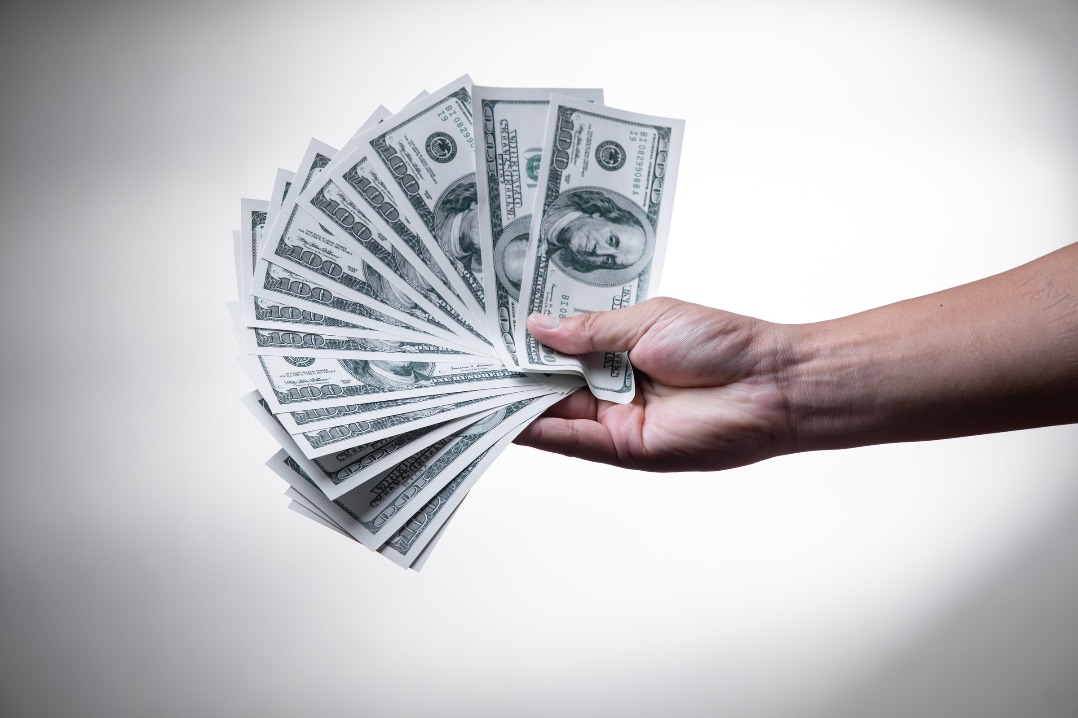When the bottom dropped out? 跌落谷底
中国日报网 2018-09-21 10:56

Reader question:
Please explain this sentence: “That’s when the bottom dropped out on my life.” What bottom exactly?
My comments:
That’s a metaphor, bottom signifying the lowest point of the speaker’s life.
Have you ever filled a big wooden bucket with water and then tried to lift it, only to see the bottom of the bucket falling off underneath, hence leaving yourself and everybody near inundated?
Well, someone must have.
Somewhere, some time.
If not in the city then in the countryside, where people still use big water buckets for drinking and for watering vegetables grown in the backyard.
The point is, it can be reasonably conjectured that sometime in the distant past, a lot of people must have had the same experience – many times, in fact, so many times that people began to use the experience to describe all disasters that make one feel like that.
Like what?
Like the bottom of a water bucket falls out – leading to mess, disaster, chaos, crisis, catastrophe.
Bottom being the lowest point, people use the expression to indicate that what’s happening is a major mess, that things have sunken to the lowest of the low, that the worst that can possibly happen has happened.
In our example, the speaker is (or rather was) addressing a period of his or her life during which they feel extremely low, low and spiritless, like never before, like, hopeless and in total despair.
All right, let’s read a few recent examples of the bottom of something falls out – to reaffirm the point:
1. The music business is back.
You could argue it just finally caught up to the technology business. Or that the rise of technology has fueled better music profits.
In fact, both are true.
After a 20-year decline, we are seeing growth—in fact, double-digit growth. Music is being created and consumed at a higher rate than ever before. More artists are on the road touring, which means fans are buying tickets and merchandise. Live music ticket sales revenue will grow from $7.2 billion U.S. dollars in 2015 to $9.1 billion in 2021, according to some estimates. Collaborations between musicians and brands are more prevalent than ever; even vinyl sales are way up (last year, sales in the U.S. grew 25.9 percent to 7.2 million units). Anyone with a laptop can create a radio-ready song from his or her own bedroom.
This is the key to conquering the music revolution.
The most exciting area of the industry right now is streaming--and, with more than 140 million active users and more than 50 million paying subscribers, Spotify is winning the arms race. The main reason we're seeing growth in recorded music is that Spotify, in particular, has expanded access to what amounts to a new music industry. In 2018, as it goes public and its savvy backers start to recoup their investments, Spotify appears set to solidify its dominance.
And sophisticated makers are going to jump on this and build on the back of the streaming platforms.
Stationhead, for example, is a breakthrough technology, in partnership with Apple Music and Spotify, that allows anyone to have a radio station from his or her own phone anywhere in the world. As it gears up to launch this quarter, it has the virality and addictiveness of Turnable.fm, but with an influencer component built in and much more substantial meaningful output that looks to have a sustainable business model. This can lead to more songs being broken and more streams for artists in general—especially meaningful for independent artists with co-signs from platforms with larger followings. Keep Stationhead on your radar.
Another exciting trend is platforms that empower the artist. Splice is a creative hub for the modern musician. It’s founder Steve Martocci believes in a world where all musicians have access to world-class tools and content that help them achieve their creative potentials. With their stems and beats in combination with tech they’re creating a new age B2B economy in service of musicians.
Companies like SuperPhone, a mobile messaging platform created by musician-turned-entrepreneur Ryan Leslie, are radically groundbreaking, as they give first-person control to the artist of their direct-to-consumer conversations. Early use cases, like Rya’s $2 million independent album cycle run over an inbound SMS campaign, illustrate the transformative power of direct access to fans—a democratization of the data-driven Amazon model where consumer insights reign supreme.
In 2018 I predict we’re going to see myriad ICO’s (Initial Coin Offerings) in the music space. There’s a pressing demand to clear the muddiness in the publishing industry. More transparency in payment is needed. Blockchain is in a position to do that, similarly to UJO, based on the Ethereum platform. More ICOs will sprout while the space is so hot. Some will win and some will flop, but an identified real opportunity for the publishing business, tracking royalty payment streams and for reimagining the liner notes business thanks to Blockchain. It’s an area and model within the music industry that’s certainly broken and ripe for disruption. And who better to do that than the Crypto-kids?
The holy grail of the music business right now is creating the music company of the future. It was the ’90s when the bottom dropped out on record labels selling music at exorbitant profit margins. To be effective, the new label model needs to be engineered to include smaller revenue streams from many angles and maximizing the full business model of artists not just as musicians, but as brands. Companies like Steve Stoute’s UnitedMasters is helping pave this way, and more are just behind it.
It’s certainly an exciting and inspiring time for those involved. Count on 2018 to be rife with more innovation and disruption from the new generation of makers.
- IT’S 2018 AND THE MUSIC BUSINESS IS BETTER THAN EVER, by Jesse Kirshbaum, Adage.com, January 2, 2018.
2. Continued strong growth in the construction industry helped keep the state’s jobless rate from increasing last month.
New figures from the Office of Economic Opportunity pegged the seasonally adjusted June unemployment rate at 4.7 percent. That’s the same as May and just a tenth of a point below a year earlier.
That compares to a national jobless rate of 4.0 percent.
The numbers reflect the loss of 4,800 jobs over the month. But Doug Walls, the agency’s research administrator, said that is not a surprise: He said the normal month-over-month loss at this time of the year is 9,100, particularly with seasonal declines in employment at private colleges as well as fewer people working at hotels, bars and restaurants.
And Walls noted that overall private sector employment is up 71,400 from the same time a year earlier.
One job out of every five added last year was in the state’s construction sector which continues to show some signs of life after the bottom dropped out in 2006.
Then, in the middle of the housing boom, there were more than 244,000 people working to build homes, offices, roads and bridges. Within months, as the recession hit and the housing bubble burst, it plummeted to fewer than 110,000.
- Arizona jobless rate same as last month, PinalCentral.com, July 19, 2018.
3. What we had here is a failure to communicate.
A decade after the financial crisis, it is clear the policymakers who averted a second Great Depression never convinced the public that what they did was right: They had to save the banks, and to save the banks, they had to save the bankers.
Those bankers started the fire, after all. The response that felt fair was to let their fire burn. Not to douse the thing in a shower of taxpayer dollars. Certainly not to let the arsonists stroll away to the comforts of their homes in the Hamptons.
The bailouts brought us a raging populism, on both left and right, led by those suspicious of not only the actions of those at the Federal Reserve and Treasury Department but their motives, too. Treasury Secretary Henry M. Paulson Jr. was a former Goldman Sachs chief, after all. The New York Fed was accused of being too cozy with Wall Street.
Yet in broad strokes, at least, what these policymakers did was correct.
We have counterfactuals to back this up. One is Europe, where policymakers took longer to intervene and ultimately enacted more punitive measures against the banks. They got substantially worse economic outcomes.
We also have a counterfactual here at home: Lehman Brothers, which failed 10 years ago this weekend.
The economic policymakers in charge then maintain that they didn’t want to let Lehman fail. They weren’t trying to teach the big bad bankers a lesson. Rather, they say, the law didn’t allow them to mount a rescue.
Nonetheless, politicians and pundits alike cheered Lehman’s bankruptcy as a deliberate choice.
It was the closest we got to the “Old Testament justice” the public wanted, to use a term often invoked by former New York Fed chairman and Obama treasury secretary Timothy Geithner. It also is when the bottom fell out and a bank run began. Unprecedented bailouts and other extraordinary measures followed.
- Heaven help us in the next financial crisis, WashingtonPost.com, September 13, 2018.
本文仅代表作者本人观点,与本网立场无关。欢迎大家讨论学术问题,尊重他人,禁止人身攻击和发布一切违反国家现行法律法规的内容。
About the author:

Zhang Xin is Trainer at chinadaily.com.cn. He has been with China Daily since 1988, when he graduated from Beijing Foreign Studies University. Write him at: zhangxin@chinadaily.com.cn, or raise a question for potential use in a future column.
(作者:张欣 编辑:丹妮)

















 英语点津微信
英语点津微信 双语小程序
双语小程序